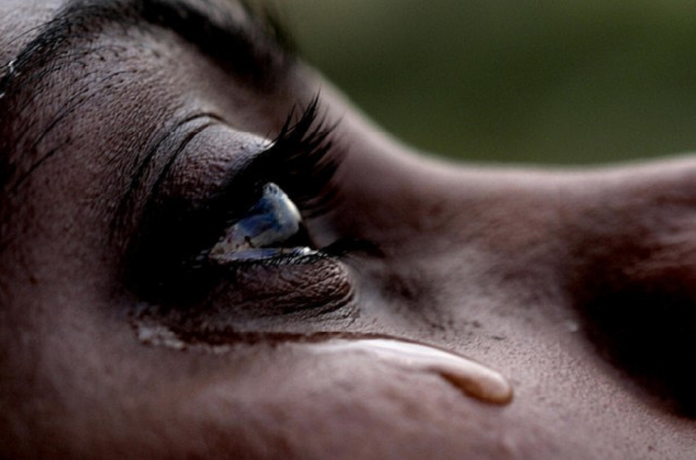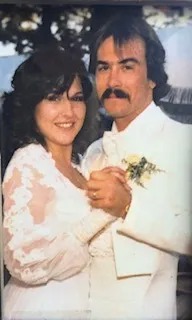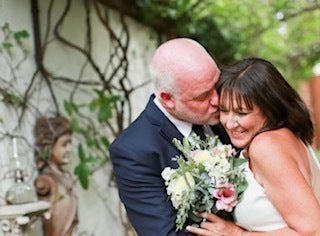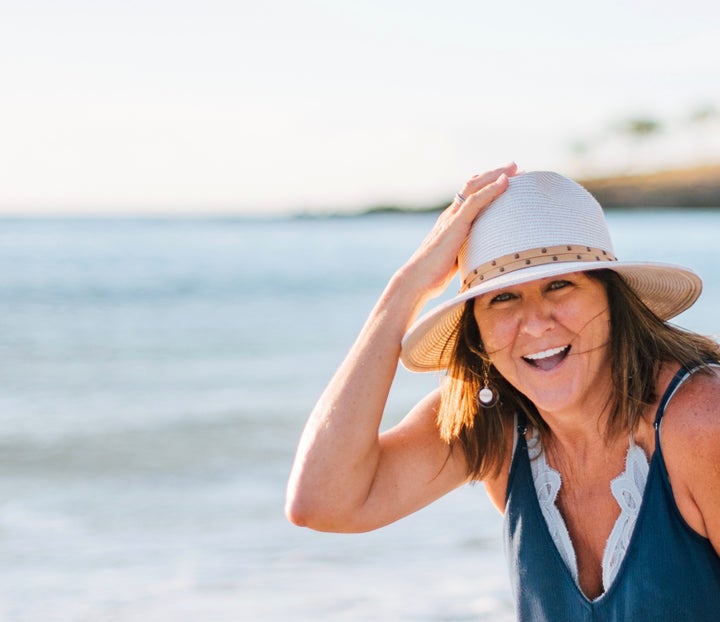
It’s April 12, 1980, and all the planning and angst over picking the right dress, flowers, reception food, perfect DJ, and honeymoon destination is done.
Friends and family are seated. Paul and I stand center stage as the bride and groom, holding hands and stealing flirtatious glances. The minister asks if we pledge “to love and cherish, for better or worse, for richer or for poorer, in sickness and health, until death do you part?”
We both say, “I do,” to these overly familiar and under-defined vows dating back to the 16th century, without hesitation or contemplation.

COURTESY OF MARCI GLIDDEN SAVAGE
We are two young adults believing that our love for each other could and would weather any storm.
I was married to Paul, my first husband, for 34 years, four months, and one day. We built a loving, happy and wonderful life during those years.
We raised two sons and a daughter — never missing a school performance, academic achievement, or sporting event, from football to baseball to soccer. We built a family business together that continues to this day. Like every marriage, we faced our share of challenges.
Growing a business and raising littles was exhausting most days, leaving little energy for nurturing our relationship.
More often than not, our love lost its rank on the priority scale, forced to sit quietly on the back burner. But love was always present. It never disappeared.
Four days before Paul died, we attended a concert. During an intermission, a younger couple sitting to my right leaned over and asked, “How do you do it?” I asked, “How do we do what?” The young man responded, “Stay in love. We don’t know you, but it’s very apparent that you guys are crazy about each other.” Paul and I smiled at each other and held each other’s hand as I turned to the couple and said, “We never fall out of love on the same day.”
And we never did.
On Aug. 13, 2014, at 5:05 p.m., I found Paul dead on our backyard patio. Cause of death: suicide. It took a second to realize what I was seeing and what Paul had done. I tried to scream, but nothing came out. In shock and trembling, I stumbled back into the house and called 911. Within minutes, sheriff’s deputies, firefighters, paramedics, and trauma intervention volunteers arrived, glancing at me as they entered the house. They seemed to move in slow motion, and I couldn’t hear their conversations over the sound of my heart beating. Thoughts popped in and out of my mind so quickly I couldn’t focus, and then I realized I had to inform my kids. Oh, God… my kids… my kids. I can’t do this, I thought.
I will never forget how their crying ebbed and flowed; screams slowly evaporated into silent gasps of air, as if with each cry, they heard the news all over, again and again. I fell to the floor with them, holding their shaking bodies and saying, “I’m so sorry!”
On the well-known Holmes-Rahe Stress Inventory, a spouse’s death is No. 1 and considered one of life’s most devastating events. The emotional fallout is impossible to describe to someone who has never experienced this loss. I felt like I was free-falling into an abyss of unwanted and unknown despair. Sadness, loneliness and disbelief were overwhelming. I wanted to supernaturally step back in time and do something, say something, anything to change this outcome. The physical pain left me curled up in a fetal position, longing for one more kiss, a chance to say, “I love you,” and one final goodbye. Every day was stressful. Every decision I made or task I needed to accomplish was hard and reminded me I was alone. But I couldn’t give grief my undivided attention. My kids were grieving. They lost one parent; they couldn’t lose another one. So, I did what I felt I had to do. I kept my grief private as much as possible and jumped into full no-holds-barred Mom mode.

My decision to move forward was difficult and very personal. I did not leave 40 years of loving Paul behind when I decided to walk on into my future. The love I shared with Paul and every shared experience was an integral part of who I was and would always be. I worked hard to live again, and I didn’t give up. I dared to dream of a future when my heart wouldn’t ache, and I would experience joy and peace again. I knew I had so much more love to give, and I believed I was worthy of being loved still.
I married my second husband, Michael, in July 2018. It was a second marriage for both of us. We were older, wiser and grateful for a second chance at love. We were past raising our families and building careers, but not free from daily distractions. Financial concerns loomed as retirement approached, and we found ourselves living between “in sickness and in health.” We found our new normal, separate from what we lived and experienced before. It’s hard to find love again at our age. A good friend and avid golfer once said, “It’s not easy finding love on the back nine!” But it was possible. Michael and I were committed to never giving up on the love that brought us together.
And we never did!
On March 16, 2019, at 2:30 a.m., the unimaginable happened. County sheriff’s deputies notified me that my second husband, Michael, was found dead in a hotel room 120 miles from our home. Cause of death: suicide. OH, GOD… NO! I CAN’T DO THIS AGAIN! Michael’s death blindsided me. I wanted to run and hide like a wounded animal to protect myself from more pain. Losing a husband again by suicide was unimaginable. My sense of safety and ability to trust was shattered, and I believed the gaping wound in my heart and soul may not be repairable. I could hear the familiar sound of grief’s voice nearby. Rapid-fire thoughts swirled in my mind: How could this happen again? How could I be so blind and so stupid? How could I have let my kids’ lives be filled with pain and disappointment again? How much is one person expected to overcome?
In a split second, I plunged further into the abyss — past the complicated, messy, and haunting grieving of one husband who died by suicide — landing in an isolated, unrecognizable place, alone and scared. The pain and suffering I fought so hard to heal from were back. The same questions, the same stigma surrounding deaths by suicide, and the same complicated, messy, horrible, painful journey lay ahead. My self-worth hung by a thread. Being knocked down again, I wasn’t sure if I wanted to get up again. I had thought I knew what lay ahead, but this time was very different.
This time the anger my family and friends felt was palpable. I often heard, “How could Michael do this knowing what you suffered after Paul’s suicide death?” or, “I heard he was selfish and a coward.” Personal attacks of the deceased in the company of a grieving widow are harmful and inappropriate. Michael left a note, so some believed he knew what he was doing, regardless of the suffering he left behind. I know there will always be doubters ― those who believe Paul and Michael chose to check out. I know Paul and Michael never wanted to cause the suffering their loved ones felt; they just wanted their unrelenting pain to end.
By design or fate, I have lived “until death do you part” twice. I know grief. I know how easy it could have been to stay mired in my losses and lose hope. I understood the complex, backbreaking work it takes to climb out of the abyss one step at a time, rebuild my shattered life, and believe I was worthy of joy and happiness again. I’ve learned a lot about love and myself. Here’s what I know:
Love changes over time. Love can happen instantly or it can grow slowly and steadily. Either way, our brains are wired for love. But the exhilarating, euphoric feeling of falling in love doesn’t last forever. After the “I can’t eat, I can’t concentrate, I can’t sleep, and I can’t be without them” dissipates, the complex work begins.
After years together, I remember moments when I would look at my husband and feel love so deep in my soul that I couldn’t possibly describe it with the vocabulary available. The innocent, tender, naïve feelings I had the day I took those vows morphed into a more significant and more profound love than I could have dreamed.
Love is risky. My dad has often said, “No guts, no glory,” when faced with a scary opportunity. Forty-two years ago, when I married Paul, I took the risk that our love would be a solid foundation, capable of withstanding any challenges, disappointments, and distractions we might face. Love was our anchor while raising three children, facing the financial ups and downs in our business, the days and months following Paul’s prostate cancer diagnosis, when depression and anxiety shifted our roles from husband and wife to spouse and caretaker, and countless times in between.

Love was riskier the second time around. I risked being vulnerable, being taken advantage of, receiving judgment for dating again, being hurt, being rejected, and the possibility of never finding someone willing to take a chance on a 57-year-old widow whose husband died by suicide. It was scary and risky. There were no guarantees.
Love is painful. That’s the consequence of losing someone you love. Pain and grief are so intense they reverberate through every part of your body ― physically, emotionally and spiritually. Love is painful on the back end.
People have often said to me, “You didn’t sign up for this,” and I always respond, “Yes, I did. The day I vowed to love and cherish, for better or worse, for richer or poorer, in sickness and health, until death do us part.”
Yet, despite love changing over time, being risky and being painful, I know love is worth it! I know the joy outweighs the heartache. I know the good times trump the bad.
I could have retreated into the memories of a life that no longer existed, replaying the past and never seeing a future. I could have added more pain to these senseless tragedies by allowing my family and friends to witness my gradual emotional, psychological and spiritual death. And no one would have expected more from me. But I didn’t. I chose to live. I mustered the courage, stamina and determination to heal following two life-shattering losses. I sought therapy and made healing my No. 1 priority. I made mistakes, and I took four or five steps back for every step forward. But I always kept moving forward and believing I could and would be OK.
One of my biggest fears was my husbands being remembered primarily by how they died and not how they lived — 58 years erased in one action. I read anything I could get my hands on about mental illness, suicide and the archaic social stigmas keeping individuals who have mental illness from speaking up and seeking help. I learned approximately 123 Americans die every day by suicide ― it’s the second leading cause of death in ages 10 to 34, the fourth leading cause of death in ages 35 to 54, and from 1999 to 2017, the total suicide rate increased by 33% and has morphed into a public health crisis. I risked my vulnerability by breaking my silence and telling my story. I chose to be part of the solution to a growing epidemic and advocate for eliminating the social stigmas surrounding mental illness and death by suicide. Will you join me?
